Are you thinking of a fun fruit to dehydrate? Well, you can’t go wrong with grapes.
Figuring out how to dehydrate grapes takes you a step closer to a fun, culinary adventure with these flexible and lip-smacking fruits.
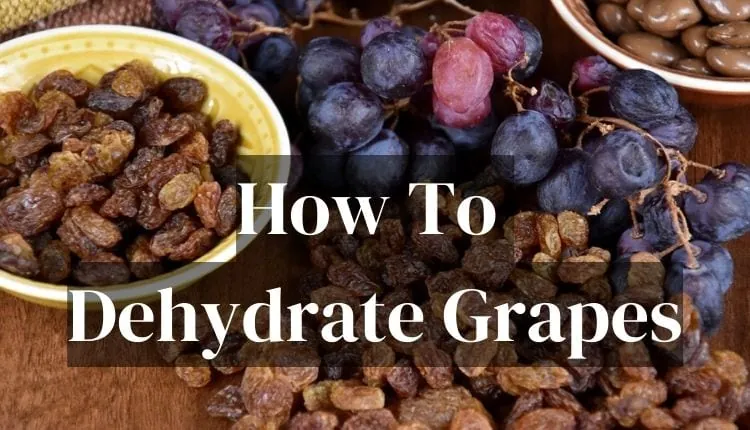
What makes grapes interesting fruits to dry at home are their gastronomical possibilities. Dried sufficiently, grapes complement a myriad of dishes.
You can nibble on dried grapes as snacks for their power-packed nutrition and flavor, add them to baked goods to satisfy a sweet tooth, or even take a savory route with various Persian and Southeast Asian dishes. The possibilities are endless!
Here’s a full-scale guide on everything there is to know about how to dehydrate grapes.
You are only a few instructions away from drying your own grapes at home using various equipment. You’ll never have to dig into your pockets again to stock up on store-bought dried grapes.
Are Dehydrated Grapes The Same As Raisins?
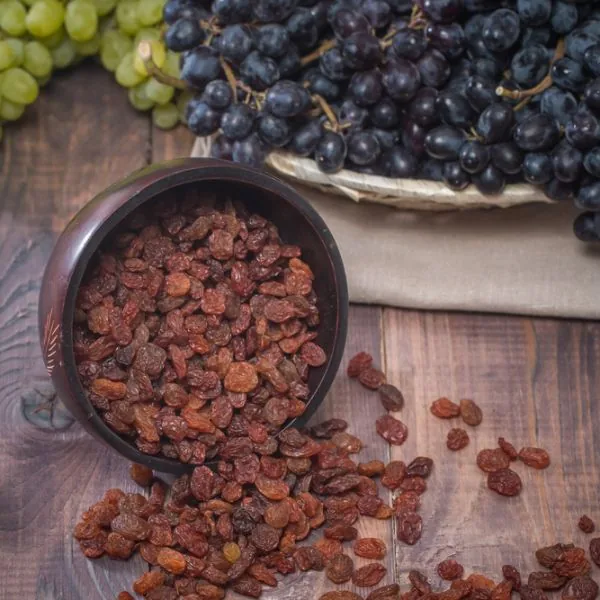
There really isn’t a difference between dehydrated grapes and raisins. Raisins refer to dried grapes with the water/moisture content drained from them.
The reason why you notice a dense and darker color on raisins is that they usually start with green skin color and darken as water is drained from their flesh.
Now, you must be asking yourself, why raisins and not just dried grapes? Well, it’s simply semantics.
The word “raisins” traces its origin in Middle English and is borrowed from the old French language. This is even evidenced in modern French where raisins translate to grapes while raisin sec translates to dried grapes.
Why Dehydrate Grapes?
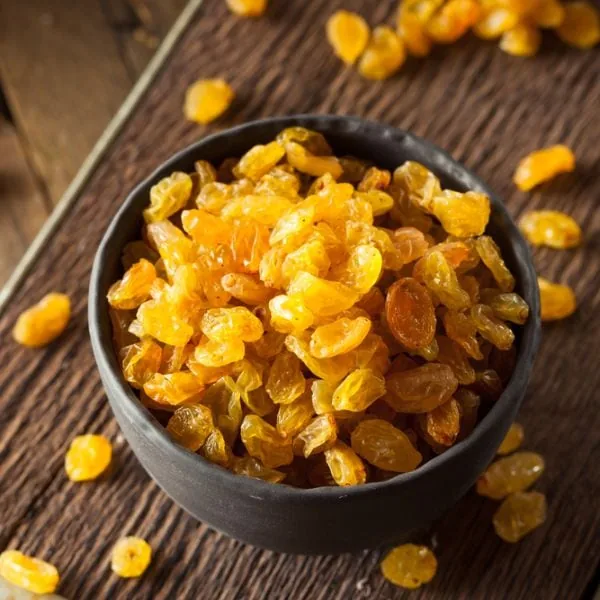
Dehydrated grapes pack a nutritional punch. Like grapes, raisins are rich in minerals and vitamins, like copper, iron, and vitamin B complex.
Additionally, dried grapes are rich in antioxidants and natural sugars to give you the much-needed energy for the day.
Dried grapes are also good for day-to-day bodily functions, like promoting digestion and preventing constipation.
So, with moderately controlled servings, you are better off snacking on raisins than candy. Dried grapes are also an excellent snacking option for when you hit the trails hiking, backpacking, or camping.
Alternatively, you can use them to build a selection of nutritious dishes in the backcountry much more conveniently. You can use raisins as toppings for your cereal, yogurt, smoothies bowls, or trail mixes.
But, unlike other fruits, dried grapes are quite versatile and complement plenty of meals at home.
Here’s how you can use dried grapes in your recipes:
- Make grape powder to use in desserts, shakes, and smoothies
- Add them to dishes like pilaf or salads
- Add them to baked treats like loaf cakes, muffins, pudding, and cookies
- Add them to a fancy cheese board
- Make sauces and chutneys
- Infuse raisins and other fruits in water for instant fruit water
- Soak raisins in water as a natural remedy to aid in baby constipation
- Make DIY face masks
How Long Do Dehydrated Grapes Last?
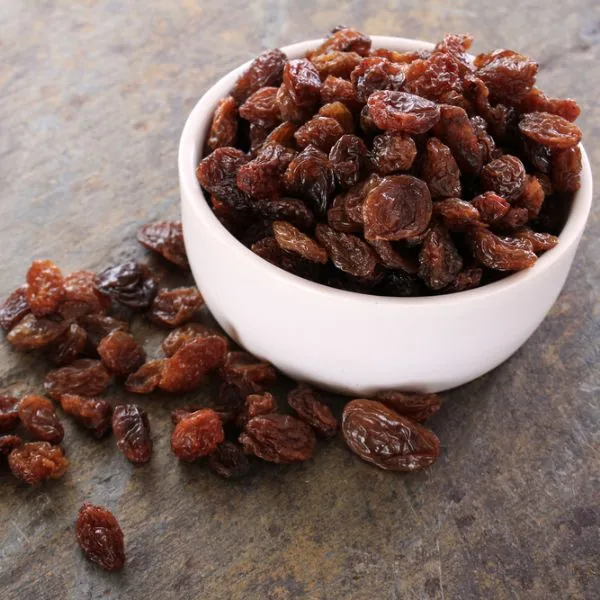
Dehydrated grapes will last you anywhere between 12 and 24 months when properly dried, conditioned, and stored. But, you have to keep in mind that even home-dried grapes start to lose their texture and quality gradually over time.
This doesn’t mean that they will not be good for consumption. It’s just that they will not taste as crunchy and fresh.
On the other hand, using additional resources like oxygen or moisture absorbers allow your raisins to last way beyond the 12 to 24 months. Store-bought raisins are usually added with artificial preservatives and dried for up to two weeks, extending their shelf life to about 60 months.
How Long Does It Take To Dehydrate Grapes?
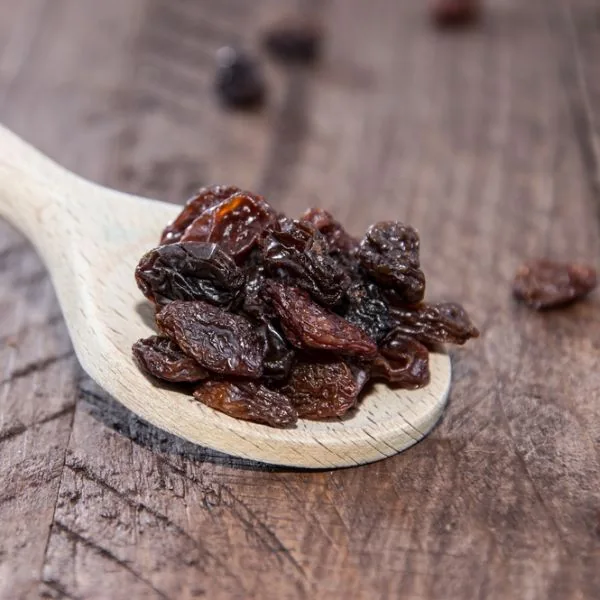
It takes about 24 to 48 hours to dehydrate grapes sufficiently. This is because grapes have high water content.
So, in addition to pre-treating them by scoring the skin, you need to dehydrate them long enough to ensure all the water dries up.
In fact, commercially available dried grapes are usually dried for about two weeks to help extend their shelf life.
You will also have to rotate the dehydrating trays (depending on the type of dehydrator you use) to ensure thorough and even drying. You should also start checking them after 24 hours to remove grapes that are already dry.
Key Factors In Dehydrating Grapes In A Dehydrator
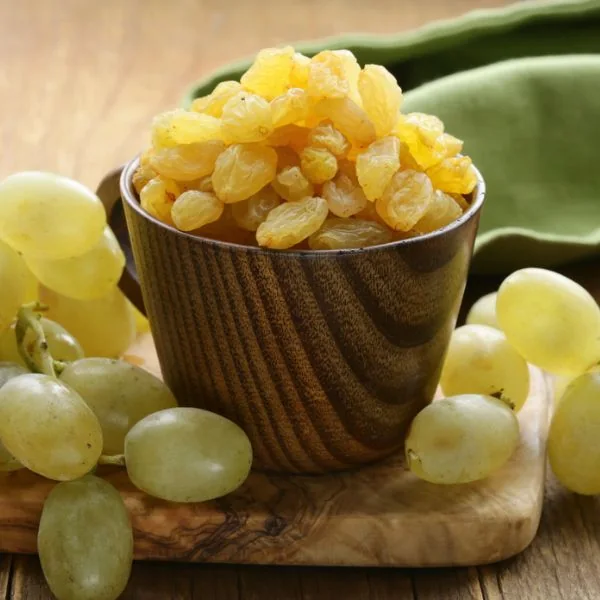
If you want to achieve the best results when drying grapes, you have to pay attention to certain key factors. Here’s what you want to consider before dehydrating your next batch of grapes;
As with other types of food, you have to pay attention to several factors when dehydrating your bananas. Here are the factors:
- Prep: Preparation is as important a step as the actual dehydration process. Therefore, you should never skip this part. Fruits like grapes have tough skin and are extremely high in moisture content. So, if you don’t pre-treat them. Without treating the grapes, you will end up with extremely dry outer skin and a moist interior. On the other hand, insufficiently treating the grapes will shorten their shelf life. Pre-treating grapes before dehydrating them ensure even drying across the entire fruit.
- Proper Arrangement: When lining your grapes on the dehydrator trays, make sure to leave adequate space between each fruit. Overcrowding the grapes will not give you good results – you’ll end up with unevenly dried grapes, some still packed with moisture.
- Temperature control: Always follow the prescribed dehydrating temperature for each fruit. After all, cranking up the heat doesn’t necessarily speed up the drying process. All it does is dry out the outer skin without so much as pulling out any moisture from the inside. To make it easier for you to know the right temperature for drying various food items, you can always find a temperature guide in your dehydrator’s manual. New models even come prelabeled with preset buttons for fruits, nuts, meats, and other common food items. So, all you do is load up your food, tap on the button, and let the dehydrator do the rest.
How To Dehydrate Grapes In A Dehydrator
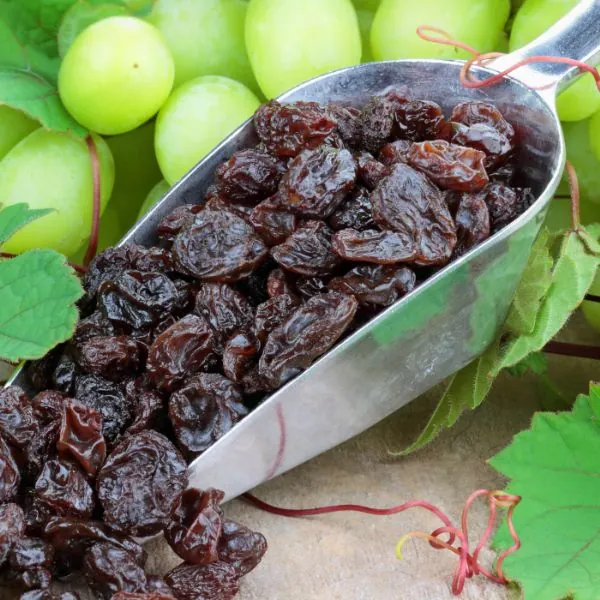
You can use any type of grapes for dehydration. However, Thompson seedless green grapes make the best variety for grapes.
You can also use the most commonly available varieties, like red and black grapes or the cotton candy variety if you want your raisins to be ultra sweet. On the other hand, if you want larger, fun-shaped but less sweet, the moon drops grape variety is a better option.
After picking the variety you want to work with, here’s how you dehydrate grapes:
Tools Needed
- Fresh grapes
- Colander
- Ice bath
- Metal strainer
- Knife
- Metal pick or skewer
- Dehydrator
Duration
Preparation time: 15 minutes
Drying time: 24-48 hours
Instructions
Here are the steps for drying the grapes;
Step 1: Wash Grapes
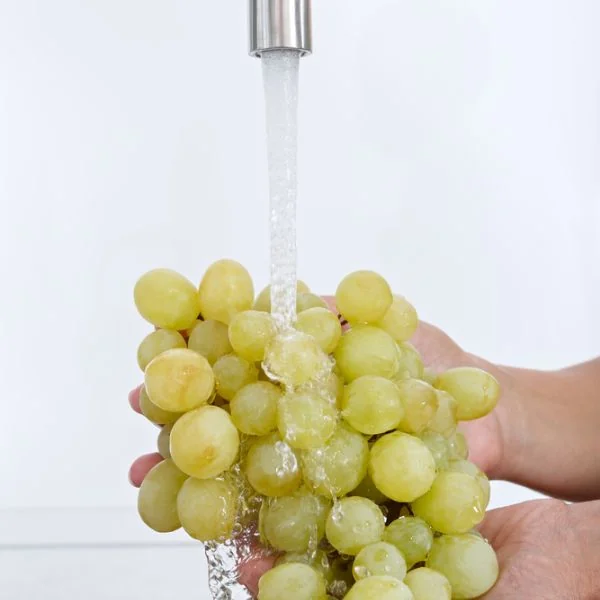
Start by washing your fresh batch of grapes in a large colander under running water and remove any debris you notice.
Step 2: Pre-treat the Grapes
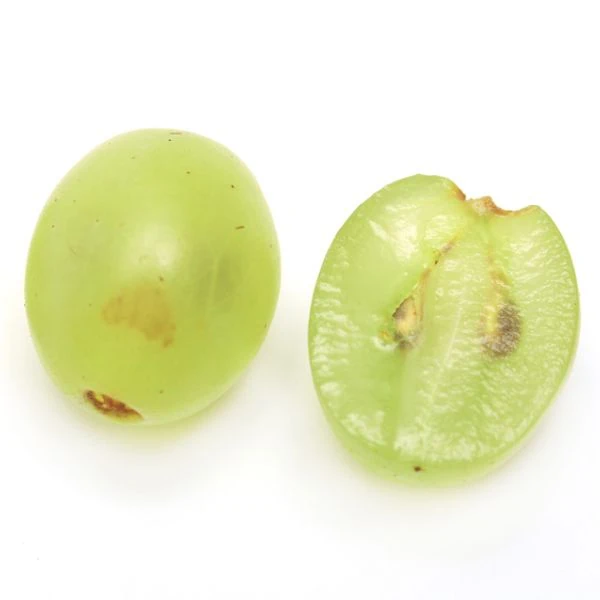
Like fruits such as blueberries, grapes have tough skin that needs to be broken so adequate moisture can escape for thorough drying. There are several ways to tear off the skin before drying and you can choose whichever works for you.
If using seeded grapes, you want to remove the seeds first. In fact, you can use any of the options below (except options one and two) to remove the seeds too.
- Option one (blanching): This is the most commonly used process when it comes to fruits that need their skin torn. It also works great for vegetables. Start by bringing a large pot of water to boil and then, dip the grapes in using a metal strainer or colander for about 15 to 30 seconds. Immediately, place the grapes into an ice bath to stop the cooking process.
- Option two (Cutting): You can also tear the skin off the same way you score meat or fish using a knife. Make a gentle cut into each grape but don’t cut all the way through. In fact, using this method of skin tearing allows you to get the same raisin results you would typically see on store-bought raisins.
- Option three (Cutting in half): You can opt for this method only if you are using the larger grapes varieties. All you do is cut the entire grape in half before popping it into the dehydrator.
- Option four (Pricking): If you don’t want to hassle with all the aforementioned processes, you can simply prick each grape to create a sufficient enough hole for moisture to escape. All you do is prick each grape with a metal pick or even a wooden skewer).
You can also use frozen grapes for your dehydration process. However, using frozen grapes eliminates the need for tearing off the skin before drying them.
This is because when you freeze the grapes, part of their skin automatically tears off due to the extremely low temperatures. So, all you need to do is thaw them at room temperature before popping them into the dehydrator.
Step 3: Arrange the Grapes on a Dehydrator Tray
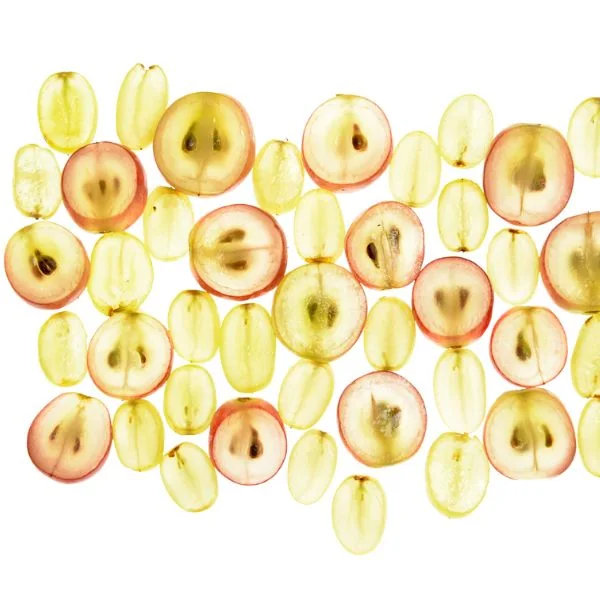
Arrange the grapes on a dehydrator, leaving adequate space between each. You should leave at least one eight to a quarter of an inch between each grape.
Step 4: Pop the Grapes Into the Dehydrator
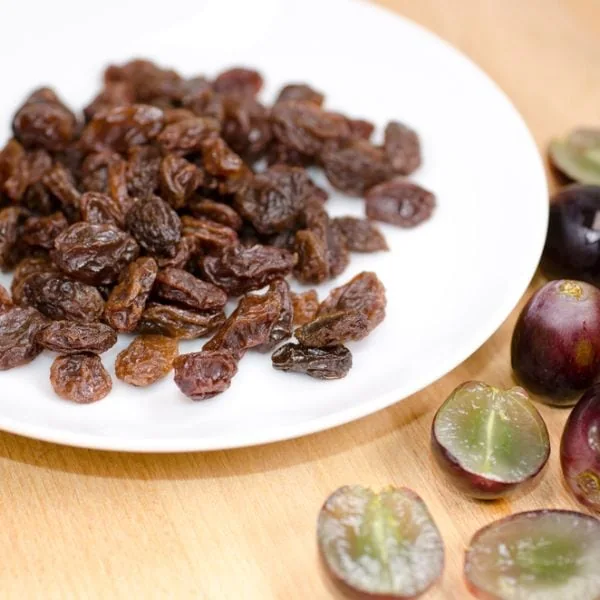
The next step is to pop the grapes into the dehydrator and dry them for 24 to 48 hours at 135 degrees Fahrenheit.
After 24 hours, check on the grapes and remove those that have sufficiently dried (if any). During this time, you can also rotate the trays around the dehydrator (depending on the type you have) to ensure even drying.
Resume drying for the next 24 hours. Of the different pre-treated grapes, grapes that are cut in half will dry faster than the rest.
It takes longer for grapes with skin intact to dry. Additionally, smaller grapes will dry faster than larger ones, typically in just 24 hours.
Other factors that affect your drying time include the humidity and even the type of dehydrator you use.
How Do I Know My Grapes Are Adequately Dehydrated?
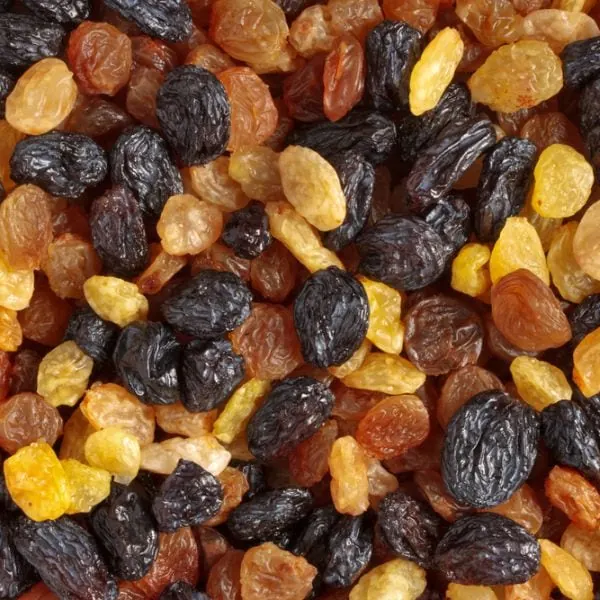
After 48 hours, open the dehydrator to test for the dryness of your grapes. Remove half or a handful of grapes from the trays and let them cool.
After cooling, feel the texture of the grapes – they should feel leathery and make a clicking sound when you drop them.
You can even slice them in half to check and ensure they don’t have a moist center. You will also notice that the grapes are much harder than store-bought ones.
This shouldn’t be a cause for concern as store-bought raisins are usually treated to remain soft.
How to Store Dehydrated Grapes
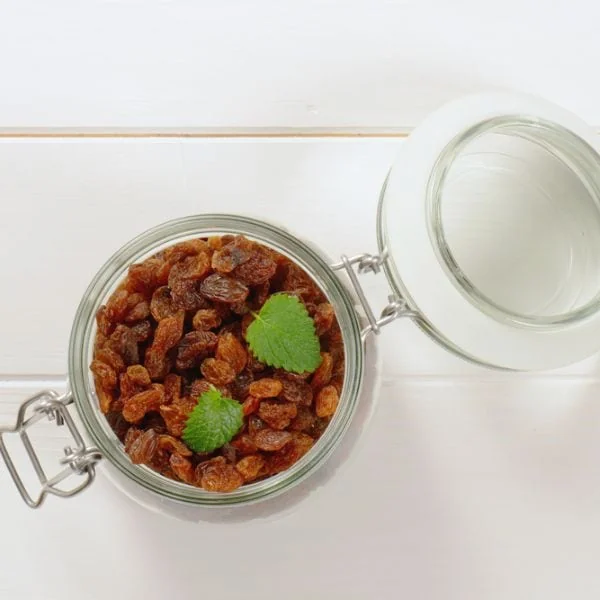
After the dehydration process, the storage of your grapes also plays an important role in maintaining reasonable shelf life. Here’s how you store dried grapes efficiently;
Condition Them First
Before you store your grapes, you have to condition them first. Skipping this step significantly reduces their shelf life, allowing for mold to build up in just a few days.
You want to condition the grapes immediately after dehydrating and cooling off. Conditioning your grapes simply means balancing the moisture and humidity levels across the entire batch.
The point of conditioning the grapes is to ensure there isn’t any moisture left or the possibility of moisture build-up later on. Now, you can condition grapes in two key methods.
These include:
- Option one (Transfer to a container): Once you confirm the grapes are sufficiently dried, remove the trays from the dehydrator and let the rest of the batch cool down. Loosely pack the grapes in a see-through airtight container (you can stock them in more than one container if one isn’t enough) and leave them on the kitchen counter for up to a week. You should check on the grapes daily until you don’t notice any moisture or mold build-up on them. If you notice mold build-up, simply discard them. Mold build-up means that the grapes weren’t properly dehydrated. You also want to shake the container daily to prevent the grapes from sticking to each other. If you still notice moisture on the grapes (with no mold), simply pop them back into the dehydrator and repeat the conditioning steps once dried.
- Option two (Leave them inside the dehydrator): After confirming that the grapes are thoroughly dried, turn the dehydrator off, and leave the grapes in there for two to three days. Follow the same steps as above to ensure there is no moisture or mold build-up.
Short Term Storage
If you plan on consuming your grapes within a few days or weeks, you can store them in an airtight container or Ziploc bag in your kitchen pantry. Other forms of dried grapes, such as grape powders don’t last that long.
Due to the high sugar content, powdered dried grapes tend to clump over time. In this case, you should only powder the grapes if you plan on using them within a day or two.
After powdering them, store them in an airtight container until ready to use. To give you the best results, add a little extra drying time to the grapes to give them a “rock hard” drying consistency.
Long Term Storage
For long-term storage, you want to store your raisins in an airtight container away from direct light and heat (ideally inside your kitchen cupboards, where it’s cool and dark). If you want to extend the lifespan even further to about two years, use an airtight container, such as a mason jar with an airtight seal or Mylar bag and vacuum seal them.
This method only works if you don’t open the container or bag frequently. So, you can always divide them into batches so you open what you need and let the rest of the batch last longer.
You can also freeze-dried grapes. However, once you remove them from the freezer, you cannot refreeze them or leave them for later.
This is because the thawing process rehydrates them.
How To Soften Hardened Dried Grapes
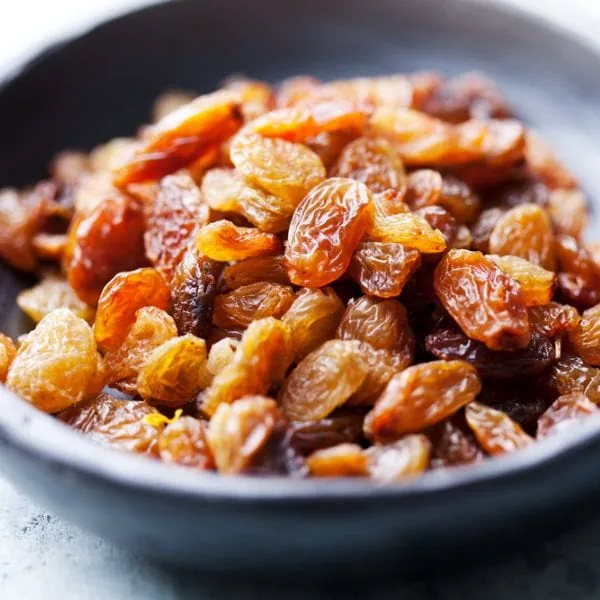
You can soften hardened dried grapes by sitting them out at room temperature or ambient moisture for a few hours before eating or using them for cooking. Alternatively, transfer them to a Ziploc bag and add a damp paper towel so they can absorb the moisture from the towel.
Most DIYers usually share the same complaint of dried grapes coming out too hard. Generally, this shouldn’t be a problem because after cooling down and conditioning, they tend to loosen up a bit.
Additionally, hardened dried grapes don’t necessarily mean they are improperly dehydrated.
In fact, fully dried and hardened grapes are necessary for long-term storage in the cupboard/pantry. You can only leave the grapes slightly soft if you plan on freezing them.
FAQs
Do you have lingering questions on how to dehydrate grapes? Here are some of the commonly asked questions about these fun fruits;
How Do I Dehydrate Grapes With Seeds?
Dehydrating seeded grapes follows the same process as seedless grapes. All you have to do is remove the seeds before the dehydration process.
This step is usually done when tearing off the skin of the grapes to ensure adequate moisture can escape during the drying process. In fact, you can simply pierce the skin with a metal skewer and remove the seeds.
This process alone is enough to deseed the grape and tear the skin so moisture can escape.
How Do I Dehydrate Grapes Into Raisins?
There’s not much difference between dried grapes and raisins.
Raisins are just another name for dried grapes. Therefore, you follow the same steps for dehydrated grapes.
How Do I Dehydrate Grapes Without A Dehydrator?
If you don’t have a dehydrator at home, there are several other ways you can dehydrate grapes.
You can use an air fryer, air fryer oven, countertop oven, conventional oven, solar oven, or microwave. Alternatively, you can take a more natural approach and sundry your grapes although this will take you significantly longer (at least five days).
It’s important to note that while these methods work, they don’t really produce dried grapes with a long shelf life. So, if you want a sufficiently dried and hardened grape, you will have to use a dehydrator.
Of the listed methods, sun drying tries its best to achieve results closest to a dehydrator.
But, the process is painstakingly long and arduous, requiring you to move the grape trays every evening and protect them from the sun and other elements.
How Do I Dehydrate Grapes In An Air Fryer?
Here’s how you dehydrate grapes in an air dryer:
- Thinly slice grapes
- Lightly spray parchment paper with cooking oil and line it on an air fryer tray/basket
- Transfer the sliced grapes to a paper-lined air fryer tray/basket
- Apply a thin layer of cooking spray to the grapes and air fry them at 130 degrees Fahrenheit for about 4 hours.
- Remove the tray/basket from the air fryer and let the grapes cool. The skin should be darkened and split when they are ready.
How Do I Dehydrate Grapes In An Oven?
Here’s how you dehydrate grapes in an oven:
- Preheat the oven to 107 degrees Celsius (preheating the oven for at least 15 minutes guarantees the best results and prevents the grapes from overcooking and drying up too much).
- Meanwhile, transfer fresh grapes into a colander and wash them under running water, removing any debris. Next, use a pair of scissors to remove any stems attached to the grapes and discard ripened or rotten grapes.
- Line the oven baking tray with parchment paper or baking sheets and brush them with a thin layer of neutral cooking oil (like canola oil).
- Transfer the grapes to the basket, and ensure they don’t touch each other.
- Transfer the baking tray to the oven and roast the grapes for four hours. During this time, you want to check the grapes from time to time. The grapes will be done once you notice they are dry and shriveled. But, they should still be somewhat plump. You will notice that smaller grapes dry sufficiently in less than four hours.
- Once you remove them from the oven, let them cool down for about 30 minutes and transfer them to an airtight container if you intend to consume them within a few days. Storing them in the fridge or freezer extends their shelf life to about a month.
Conclusion
Learning how to dehydrate grapes is one way to bring excitement to a DIYer’s kitchen. Due to their versatility, grapes can be dried in a myriad of fun ways, extending their recipe possibilities.
However, it’s not only the ability to add them to various recipes that make dried grapes a good dehydrating food item. They also pack a punch when it comes to nutrients, including minerals, vitamins, and antioxidants.
So, it’s not a bad idea to stock up on home-dried grapes you can incorporate into your diet daily. Their rich nutrients also make dried grapes excellent options when you hit the trails for your next backpacking or camping trip.
The best part is you won’t be spending a cent on store-bought raisins.






I wish you could have explained exactly how cutting the grapes in half before dehydrading will remove the seeds. After cutting in half, is it necessary to pick out the seeds?
More detail about removing grape seeds before dehydrating, please.